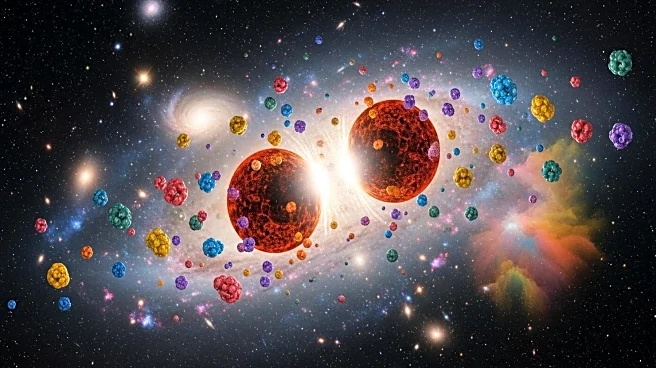What is the story about?
What's Happening?
Recent simulations conducted by researchers from Penn State and the University of Tennessee Knoxville have revealed that the mixing and transformation of neutrinos during neutron star mergers significantly affect the composition and structure of the merger remnant. Neutrinos, which are fundamental particles that interact weakly with other matter, can change flavors under specific conditions, impacting the types of particles they interact with. This transformation influences the creation of heavy metals like gold and platinum, as well as rare earth elements. The study, published in Physical Review Letters, is the first to simulate these neutrino flavor transformations in neutron star mergers, providing insights into the cosmic origins of these elements and the physics in extreme environments.
Why It's Important?
Understanding the role of neutrino mixing in neutron star mergers is crucial for comprehending the cosmic origins of heavy elements and rare earth materials, which are essential for various technologies, including smartphones and electric vehicle batteries. The findings suggest that accounting for neutrino mixing could increase the production of these elements by up to a factor of 10, offering a deeper understanding of the universe's elemental composition. Additionally, the study enhances the interpretation of emissions from neutron star mergers, such as gravitational waves and electromagnetic radiation, which are detectable from Earth. This knowledge is vital for astronomers using advanced detectors like LIGO, Virgo, and KAGRA to study cosmic events.
What's Next?
The research team anticipates that other groups will utilize the simulation technology to further explore the impacts of neutrino mixing in neutron star mergers. As theoretical particle physics advances, these simulations can be improved, providing more accurate models of these cosmic events. The study's findings may influence future observations and analyses of gravitational waves and electromagnetic emissions, aiding astronomers in interpreting data from next-generation observatories like the proposed Cosmic Explorer. Continued research in this area could lead to significant advancements in understanding extreme physics and the universe's elemental makeup.
Beyond the Headlines
Neutron star mergers serve as cosmic laboratories, offering insights into extreme physics that cannot be replicated on Earth. The study highlights the importance of including neutrino mixing in future models to better understand the processes occurring during these energetic events. The research also underscores the potential for neutrino transformations to impact the emissions detectable from Earth, which could alter the way astronomers interpret cosmic signals. As the infrastructure for complex simulations is established, the scientific community is poised to make further discoveries about the fundamental processes governing the universe.
AI Generated Content
Do you find this article useful?

















